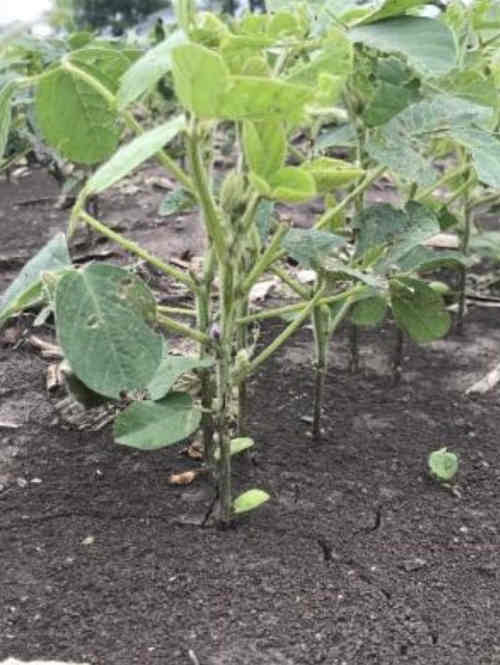By Meaghan Anderson
Staging crops is an underappreciated but incredibly important skill. One very important reason to know how to stage your crops is because herbicide products may have limits on what growth stages of the crop they can be applied. This ICM Blog will discuss staging corn and soybean as well as share resources that can be used to double check herbicide labels prior to spraying your crops.
Note: When a field of corn or soybeans has 50% or more of the plants at a given stage, the field is at that growth stage.
Staging Corn
Corn growth stages are classified as vegetative or reproductive. The leaf collar method is one method used to stage corn while it is in the vegetative stages. With this method, the vegetative stages are based upon the number of visible leaf collars. Staging begins at emergence (VE), and each new leaf with a fully developed leaf collar is called stage V(number). Figure 1 below shows a corn plant at V2 because it has two leaves with a fully developed leaf collar. The third leaf does not have a collar yet. Vegetative leaf staging for corn plants ends when the corn develops a tassel (VT); once the plant has silks visible outside of the husks it has reached the first reproductive stage (R1). Read more about corn growth staging
here.
Figure 1. Corn at growth stage V2. Photo by Meaghan Anderson.
Many herbicide labels have restrictions that eliminate the option of spraying once corn reaches stage V6 or earlier. Check the herbicide label on the product or on a website like
www.cdms.net to determine the stage at which herbicide applications should cease.
Staging Soybean
Just like staging corn, soybean growth stages divides plant development into vegetative (V) and reproductive (R) stages. The vegetative stages are numbered according to how many fully-developed trifoliate leaves are present. Soybean plants will continue to produce new leaves throughout most of the growing season, but the reproductive (R) stages begin when the first flowers develop on plants and include pod development, seed development, and plant maturation.
Soybean growth staging is especially important this time of year as soybeans will soon begin flowering due to their photoperiod sensitivity. Flowers have already been observed in some of the early planted soybean fields in Iowa. When soybeans are planted early or we have warm weather in the early growing season, plants may begin flowering before the summer solstice. When soybeans begin to flower, they have reached the reproductive stage. We stop counting the number of trifoliate leaves. Soybean flowering begins with stage R1, which is defined as when 50% of the plants in a field have at least one flower anywhere on the plant (Figure 2). Stage R2 is when 50% of the plants in the field have a flower at one of the two uppermost nodes on the plant. Read more about soybean growth stages
here. Many soybean herbicide labels have restrictions once soybean fields reach flowering. It is important to know the limitations of postemergence herbicides for soybean fields, know the crop stage of the soybean field you plan to treat, and be aware of the rotational restrictions to corn next year before application.

Figure 2. Soybean plant at stage R1 (flower on any node of the plant). Photo taken June 19, 2019 by Rebecca Vittetoe.